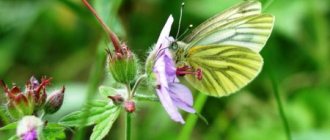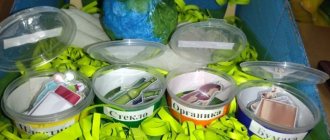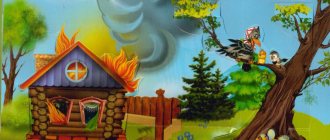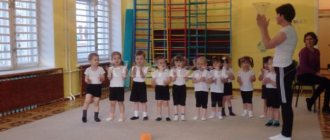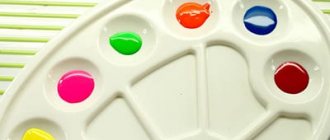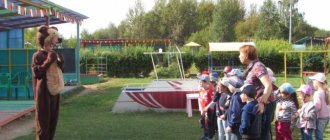Junior group. Early childhood, nursery. Children 1-4 years old
Poster "Take care of nature." Collaborative activities between teachers and young children
Poster "Take care of nature "
. Joint activities of a teacher with young children. From an early age, children need to be instilled with the concept that the planet is our common home, we need to take care of it, protect it with all our might: we need to protect the air we breathe, we need to save the water that...
Summary of the lesson on ecology “Take care of nature” (second junior group) In MBDOU 288, group 5, environmental lessons were held as part of the All-Russian campaign “ Ecolyats - Young Nature Defenders ”. While working with children, we touched on the topic “Take care of nature ,” formed a responsible attitude towards nature , increased the level of environmental ...
Summary of a lesson on ecology in the 2nd junior group
Summary of a lesson on ecology in the second junior group “What kind of inhabitants live in the forest?”
Goal: to introduce children to what animals live in the forest of the Stavropol Territory, to consolidate knowledge about animals. Objectives: To teach to distinguish animals living in the forest - to give children an idea of what animals eat in the forest - to develop attention, to cultivate curiosity. Preliminary work with children: looking at pictures of wild animals, reading fiction about the forest and its inhabitants, memorizing poems and riddles about wild animals. Materials: pictures depicting a bear, hedgehog, hare, squirrel and their houses (hollow, hole, den) Activation of the dictionary: Hollow, den
Progress of the lesson:
To the music Composition (Birds singing), A teacher with children enters the hall. Educator: Children, today we will go on a trip, but where do you think we will go? The teacher reads a poem about the forest and its inhabitants. The world created by God is very interesting! We will watch him now together. The Creator settled a hare, a squirrel and a fox in the forest. Follow the path into the forest and look at the forest dwellers! Here the hare brought all the bunnies out onto the grass: A squirrel on a branch - hop! Who doesn't know her?! A nimble little animal, the Hedgehog rustles its leaves, insulates the Mink; There is a mushroom under the aspen tree, He picks it. Why do you have a sweet tooth, Little Bear, tell me? But the bear doesn’t hear the question, he’s already eating raspberries. Educator: This is a wonderful forest! And who is it that meets us? Can you guys guess the riddle? He lives in a hollow and gnaws nuts? (squirrel) Educator: Yes, guys, squirrels live in our forest. Where does the squirrel live? (in a hollow) And on what tree did the squirrel make its house? Children, what kind of squirrel? (She is small, fast, jumps on branches, the squirrel has a fluffy tail) - the squirrel collects nuts, mushrooms, pine cones. And where does the squirrel hide its reserves? (It hides it in its hollow), absolutely right, guys. It’s time for us, children, to set off further on our journey, and in front of us is someone’s house. Who lives in it, guess? Long ears Fast paws Gray but not a mouse Who is it? (Bunny) Children, what kind of hare? (Bunny has long legs, long ears) Guys, what does the hare eat? (Carrots, cabbage) That's right, kids. And now we will hurry further. What kind of house is ahead? Who lives in it, tell me? The beast goes to the transshipment For raspberries and honey He loves sweets very much And when autumn comes He climbs into a hole until spring Where he sleeps and dreams (a bear) This is, of course, a bear. Children, what kind of bear is it? (big, clumsy, club-footed,). What does a bear like to eat? (honey, berries) that's right guys. Where does the bear live? (in a den) correct, and under what tree did the bear build his house? (near Berezka) absolutely right, kids. We'll go further along the path, look who's under the bush? A living ball of needles is running between the trees. Suddenly a wolf appears. The ball stopped instantly. (hedgehog) That's right, guys. What kind of hedgehog do we have? (small, with needles) children, tell me what does a hedgehog like to eat? (apples, mushrooms) absolutely true. When the hedgehog met us, he curled up into a ball, don’t be afraid, hedgehog, we won’t hurt you. Guys, it’s time for us to return to the group, we saw a lot of animals today: A hare, a bear, a squirrel, a hedgehog, we learned a lot about them What they live in (dens, holes, hollows), you and I learned what kinds of animals there are (clumsy, fast, dexterous.) But we have not yet seen all the animals that live in our forests (foxes, wolves, roe deer). At our next lesson with you, we will definitely meet the rest of the inhabitants of our forests. Children know poems about the forest inhabitants of our forests. 1. In the heat in the forest, the hedgehog washes itself, sleepy. The mother hedgehog takes the basin and rubs the little hedgehog's face. Only your back, only your back You won’t rub your own son. He walks through the dew of the forest with an unwashed back. This is how it is with hedgehogs, judge for yourself. Okay, guys, anyway, none of you are hedgehogs! 2. The squirrel gallops, the squirrel gallops and hides nuts in a hollow, the horse jumped up to her, and dropped her straight into the house.
We recommend watching:
Synopsis of a research and educational lesson in the 2nd junior group “Let's help the bear cub sew on a note of the educational activity using health-saving technologies “On a visit to the sun” for younger children Synopsis of the educational activity in the 1st junior group on FEMP “Let's treat the Bunny with a carrot”
Summary of educational activities in the 2nd junior group “The first step on the path to health”
Similar articles:
Summary of GCD in the 1st junior group by February 23
Summary of GCD on FEMP in the junior group of kindergarten “Trip on a Train to the Forest”
Summary of an integrated lesson in artistic creativity and mathematics in the 2nd junior group
Summary of a design lesson in junior group 1
Summary of a comprehensive final lesson in the first junior group
Summary of a lesson on ecology for the junior group “Water”
Summary of a lesson on ecology in the junior group of the “Water” kindergarten.
Goals:
1. Clarify children’s understanding of the importance of water for all living things: plants, animals, humans.
2. Talk about the importance of water in our lives. To give children the first basic knowledge about the water cycle in nature.
Software tasks:
1. Educational objectives.
Give children knowledge about the properties of water (taste, color, smell).
2. Corrective tasks.
Develop hand-eye coordination, memory, attention.
3. Educational tasks.
Cultivate an attentive and caring attitude towards nature.
Materials: cups of boiled water according to the number of children, 3 transparent cups, one cup of salt water, one of sweet water, cups of warm and cold water.
Progress of the lesson: To the music, a teacher in a “Water” costume enters under a blue umbrella and greets the children.
Educator: Hello, guys! Listen to the poem.
Poem Journey of a Droplet
Here is a little droplet that fell from the clouds to the ground. The poor thing was confused, she didn’t know what to do. But suddenly a cheerful stream ran past, and he dragged the upset droplet with him. Where he led her, the droplet did not know, but soon she saw millions of the same ones, similar to each other. There is a giant in front of her. And the droplet guessed that this was the ocean. Living in the ocean is cramped and the droplet is tired. One day on a wonderful day, the sun was so hot that the droplet suddenly began to quietly decrease. And as she decreased, she began to rise upward. A drop fell to the top, And here you learned: In nature, the Water cycle occurs.
What is water?
What is water? These are rivers and the sea, This is the ice of Antarctica, this is snow or hail. This blue lake is there in the open, And a beautiful and loud river waterfall. And a spring stream, and an autumn puddle, What is water? - I will answer easily. This is something that, undoubtedly, we vitally need, that has entered deeply into the fate of a person.
Educator: What is water for, how do we use it? (we drink, wash our hands, bathe, do laundry, wash the floor, water the flowers).
Educator: Guys, where does the water come from when we wash ourselves? That's right, from the tap. But to get to our house, water travels a long way. Look - this is a fontanelle. The fontanel is small, it flows out of the ground. And a cheerful stream flows from the spring. Let's play trickle with you.
Outdoor game "Streams".
Educator: a stream flows and ends up in a river. The river is small at first, and then it gets bigger and bigger. The river flows into the sea. The sea is very large, the waves crash against the shore. Listen to music. (Music is playing).
While we were playing, you probably got thirsty, come to the table, look, here’s the water, I suggest you guys taste the water. (Children are offered boiled water, each). What is she like? Sweet? Salty? Bitter?
Educator: That's right, water has no taste, it is tasteless.
Educator: Now let’s conduct an experiment, try the water that is on my table (the teacher pours sweet water into several glasses). Invite several children to try the water. What did it taste like? (Children's answers). What do you think I added to the water? (Children's answers) Educator: It turns out that water can take on the taste of the substance that was added to it.
Educator: And now, I suggest you guys smell the water. Does the water smell anything? (Children's answers). Water has no smell.
Educator: Guys, water can change color depending on what is added to it. (Dips the brush with paint into the cup).
Educator: Guys, we learned that water has no taste, color or smell.
- Well done guys, they did it all. And now we’ll take a little rest and play the game “Droplet and Cloud”. Outdoor game "Droplet and Cloud". The droplets flew to the ground, jumped and played. They gathered together and flowed in merry streams (holding hands they form streams). Streams met and became a big river (connected in one chain). The droplets float in a big river and travel. The river flowed and flowed and ended up in a big, big ocean (children form a round dance and move in a circle). We swam and swam in the ocean, and then we remembered that mother cloud told us to return home. And just then the sun came out. The droplets become light (the crouched droplets rise, then stretch their arms up). They evaporated under the rays of the sun and returned to mother cloud.
Educator: Do you guys know that you need to save water, and when you wash your hands, you need to immediately turn off the tap?
Guys, now I suggest you draw droplets. (Children draw droplets on a sheet of paper with their hands.)
Educator: Well done, guys. So we learned so much new about water. Did you like it? And now it's time for me to leave. See you!!!
Summary of the ecology lesson “How animals prepare for winter.” Second junior group
Lesson on ecology in kindergarten in the second junior group “How animals prepare for winter”
Description: I present to your attention a summary of the lesson in the 2nd junior group on environmental education. During this event, children will learn how animals in the forest prepare for winter, the characteristic features of forest inhabitants, and their appearance. Age category: second junior group. Goal: To form in children a general idea of how animals prepare for winter. Tasks. Educational:
1. To form ideas about seasonal changes in nature: it becomes cold, snow falls, animals hibernate, change the color of their fur coat.
2. Expand ideas about the life of wild animals in the forest, what they eat, how they adapt to life in winter conditions, their homes. Developmental:
1. Develop speech abilities (learn to formulate your impressions).
2. Develop the ability to analyze, observe, compare Educational:
1. Cultivate cognitive interest.
2. Foster a friendly and caring attitude towards nature and animals. Preliminary work. Conversation with children about winter changes in nature, about animals; reading E. Charushin’s story “Wolf”, fairy tales “Zayushkina’s Hut”, “Rukavichka”; outdoor game “Train”, d/i “Domestic and wild animals”, d/i “Let’s get dressed for a walk”. Material: images of animals (a wolf and a fox, a hare in a white and gray coat, a red and gray squirrel, a bear), images of animal dwellings (a hollow, a hole, a den).
Didactic game “Who Lives Where” (learn to correlate an animal with its home). Move
Children sit on chairs in a semicircle.
Educator: Guys, look out the window, what time of year is it now? Children: Winter Educator: How did you know that it is winter now? Children: It snowed, people put on warm jackets, hats, mittens, felt boots... Educator: Well done, when winter comes, snow falls, the air becomes cold and people dress warmer so as not to freeze. Guys, do you want to go to the winter forest? Children: Yes. Educator: Great, but since it’s cold outside now, we have to get dressed before we go into the forest. Show us how you will dress, what will you wear first? A didactic game “Who will wear what” is played (in order to consolidate ideas about clothes and shoes, the purpose of things). Children imitate the movements of the sequence of putting on clothes. Children: First we will put on tights, pants and boots, then we will put on a jacket and a hat, after that we will put on a coat (jacket) and tie a scarf. Let's put gloves on our hands. Educator: Correct. Why did we dress so warmly? Children: Because it's cold outside. Educator: Correct. Guys, you and I began to dress warmly, but how did the animals in the forest prepare for the cold? Children: The animals change their coats and go to bed. Educator: Well done! Let us go into the forest and see how the animals have prepared for winter. Let's go to the forest by train! Stand behind each other, I will be the locomotive, and you will be the carriages (p/n “Train”). - Here we are! Physical education minute. Show me, guys, how animals live in the forest, how a little fox wakes up, how a little squirrel washes itself, how a little hare galloped, how a wolf cub ran!
(children imitate movements in accordance with the text)
Educator: Here we are in the forest, let's sit on stumps (chairs) and behave quietly so that the animals do not get scared of us. Tell me, please, what are the names of the animals that live in the forest? Children: Wild. Educator: Correct. In the group in different places there are illustrations of forest animals. Educator: Now I’ll tell you a riddle, and you listen and tell me who it’s about. A ball of fluff, A long ear, Jumps deftly, Loves carrots Who are these guys?
(bunny)
Educator: Well done! This is a bunny, he has long ears, he jumps deftly and loves carrots. Let's come closer to him (the children, together with the teacher, approach the image of the hare). What does a bunny do in the forest in winter?
Children: Runs, jumps. Educator: That's right, do you guys know what color a bunny's fur coat is in winter? What kind of fur coat in summer? Maybe someone can tell me why? (children's answers) Educator: Yes, in the summer the bunny is gray, it is easier for him to hide in the grass. In winter it snows and everything around is white. To prevent the fox and gray wolf from finding the bunny, he changes his fur coat and puts on one as white as snow. Do you know what a bunny eats in winter and where he lives? Children: Eats tree bark.
Educator: Yes, but the bunny doesn’t have a house; he hides from the winter cold by burying himself in the snow under the bushes. Now listen to one more riddle: Today she deftly brought cones into the pantry, Yes, on sharp branches, and hung mushrooms.
Who is this? (squirrel)
Educator: That's right, it's a squirrel. She lives in the trees and prepares supplies from cones and mushrooms. Let's try to find a squirrel in our forest and go up to it (children go with the teacher to the image of a squirrel).
What is a squirrel doing in the forest? Children: Jumps through trees, collects cones and mushrooms. Educator: Well done, where does she put them? Children: To the house. Educator: Who knows what the squirrel’s house is called? (children's answers) That's right, hollow. The squirrel carries its supplies into a hollow, which is located in a tree, so that in winter it will not be cold and hungry. What do you think, does the squirrel change its coat for a winter one?
Children: Yes. Educator: Well done! Look, the squirrel changes its coat from red to gray (the teacher shows an illustration). Now listen to another riddle: Cunning head, Red-haired cheat, Fluffy tail - beauty, Who is it?
(fox)
Educator: Yes, this is a fox, she is red, very cunning and has a fluffy tail. Let's approach her quietly on tiptoes so that she doesn't notice us.
What is a fox doing in the forest? (children's answers are listened to). The fox has a keen sense of smell, even through the snow she senses where the burrows of hedgehogs and mice are, so she hunts for them, and even manages to scare bunnies. Where does the fox live? Children: In the hole. Educator: That's right, look at her mink.
Here's another riddle for you: He is big and clumsy, Club-footed and funny, He lives in a dense forest, He loves fragrant honey very much.
(bear) Well done, it's a bear.
He is big, club-footed and lives in the forest. Where is the bear, why is it not visible in the forest? Children: He's sleeping. Educator: Where does the bear sleep? Children: In the den. Educator: Yes, guys, a bear was walking through the forest, walking, there were no raspberries or strawberries here, what should he do? Nothing. So the bear decided to lie down to sleep in his den for the whole winter. He brought some dry leaves there to keep warm and fell asleep.
Let's move away from the “den” (picture of a bear in a den) so as not to wake him up. Look around, who else have we not noticed?
Children: Wolf! (together with the teacher they go to the image of a wolf). We just won’t get too close to him, because he’s very angry. Educator: Look, what color is his fur coat? Children: Gray. Educator: Well done! In winter, wolves gather in packs and walk in a chain (the teacher shows an illustration of a pack of wolves).
Wolves usually make their den among the roots. Wolves also run very quickly through the snow and catch their prey: hares and foxes. How many animals we saw in the forest! But it's time for us to return to kindergarten. Get on the “train” and let’s go to the group (Outdoor game “Train”). Here we are! Did you like it in the forest? Children: Yes! Educator: I really liked it too! Let's now play the game "Who lives where." You and I will need to place each animal in its own “house”. Otherwise, the animals all played together and lost their homes. Shall we help them? Children: Yes! The teacher invites the children to choose a picture of any animal (wolf, fox, hare, bear, squirrel) and bring it to the house (mink, bush, den, hollow). During the game, if the children have difficulties, the teacher helps the children. The teacher also asks questions: “Which animal did you choose?”, “What is the name of its house?”, “What color is this animal’s coat?” Educator: Well done. Well, we looked at how animals prepare for winter. We found out which animal has which home. Let's remember who we saw in the forest? Children: Squirrel, hare, fox, wolf and bear. Educator: What were the animals doing in the forest? Children: The bunny was jumping, the bear was sleeping, the squirrel was collecting nuts, the wolf and the fox were running. Educator: How did the animals prepare for the cold? Children: The hare changed his fur coat to white, the squirrel to gray, and the bear fell asleep in the den. Educator: Well done, guys! Everyone remembers! I really liked the way you behaved in the forest: you didn’t make noise, you walked carefully so as not to scare the animals, you didn’t come close to dangerous animals!
We recommend watching:
Lesson on ecology in the 2nd junior group. Summary of a lesson on ecology in the 2nd junior group. Acquaintance with a horse and a foal Lesson on environmental education for children 2-3 years old “A droplet does not come alone!” Summary of a lesson on familiarization with the outside world in the younger group. Wild animals
Similar articles:
Summary of a game lesson for young children on the topic: Winter
